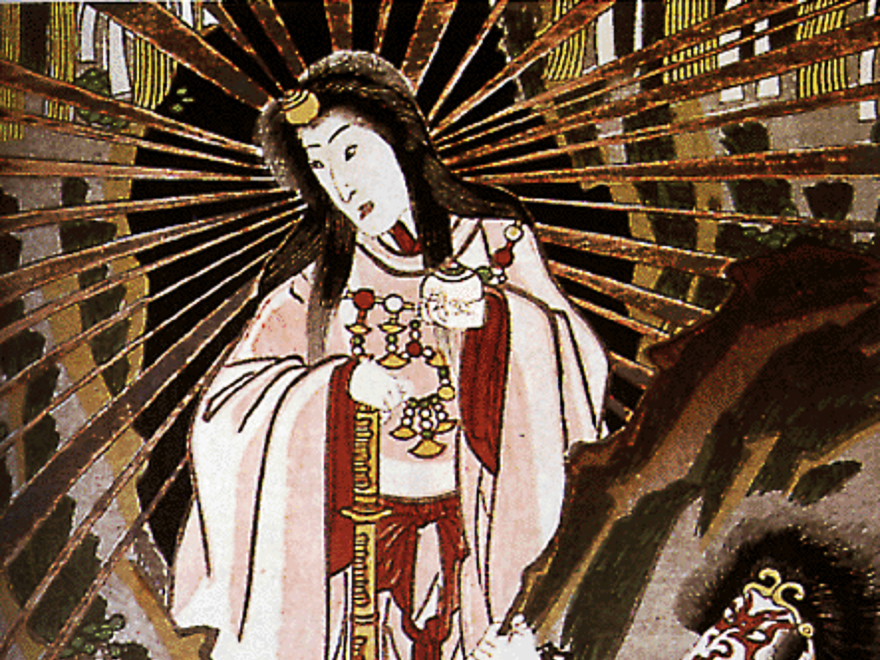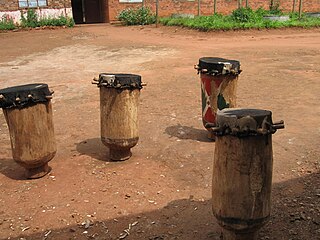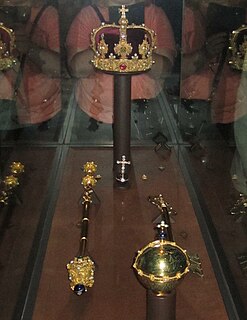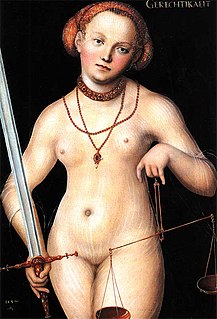 W
WRegalia is a Latin plurale tantum word that has different definitions. In one rare definition, it refers to the exclusive privileges of a sovereign. The word originally referred to the elaborate formal dress and dress accessories of a sovereign, but now the word usually refers to any type of elaborate formal dress and dress accessories.
 W
WAboriginal breastplates were a form of regalia used in pre-Federation Australia by white colonial authorities to recognise those they perceived to be local Aboriginal leaders. The breastplates were usually metallic crescent-shaped plaques worn around the neck by wearer.
 W
WAn armill or armilla is a type of bracelet, or armlet, normally in metal and worn in pairs, one for each arm. They were usually worn as part of royal regalia, for example at a coronation, or perhaps as part of especially grand liturgical vestments. They may have been worn outside ceremonies. Armillae presumably descend from the Ancient Roman armilla, which was a form of military decoration. These in turn seem to have developed from the armlets worn by some "barbarian" nations, including the ancient Celts and Scots. The form is variable; all three examples discussed below have completely different forms.
 W
WThe Imperial Regalia of Brazil consists of the Imperial Crowns: the Crown of Pedro II and the Crown of Pedro I; the Imperial Sceptre; the Imperial Orb; the Imperial Sword; and jewelry belonging to the Emperors and Empresses of Brazil. They were used until the abolition of the Brazilian monarchy in 1889. Most of the jewels have been displayed at the Imperial Museum of Brazil in Petrópolis and at the National Museum of Brazil in Rio de Janeiro since 1943. Other items are stored at the National Treasury in Brasília.
 W
WThe colobium sindonis is a simple sleeveless white linen shift worn by British Monarchs during part of the Coronation service. It symbolises divesting oneself of all worldly vanity and standing bare before God.
 W
WA coronet is a small crown consisting of ornaments fixed on a metal ring. By one definition, a coronet differs from other kinds of crowns in that a coronet never has arches, and from a tiara in that a coronet completely encircles the head, while a tiara does not. By a slightly different definition, a crown is worn by an emperor, empress, king or queen; a coronet by a nobleman or lady. See also diadem.
 W
WThe crook (heka) and flail (nekhakha) were symbols used in ancient Egyptian society. They were originally the attributes of the deity Osiris that became insignia of pharaonic authority. The shepherd's crook stood for kingship and the flail for the fertility of the land.
 W
WThe Crystal Sceptre is part of the regalia of the Lord Mayor of London. It was presented to the City of London by King Henry V in return for having provided the king with 10,000 marks (£6,666) to fund a war in France in 1415, when his army captured Harfleur and then won the Battle of Agincourt.
 W
WDanish Crown Regalia are the symbols of the Danish monarchy. They consist of three crowns, a Sceptre, Globus cruciger, the Sword of state and an Ampulla . The Danish Royal Regalia are kept in the treasury at Rosenborg Castle. The oldest of these is Christian III's sword of state from 1551. They further include King Christian IV's diamond; pearl- and gold-embroidered saddles; objects carved from ivory and rock-crystal; lapidary pieces of precious stones, and brooches in the form of fantastic animals.
 W
WThe enthronement of the emperor of Japan is an ancient ceremony that marks the accession of a new monarch to the Chrysanthemum Throne, the world's oldest continuous hereditary monarchy. Various ancient imperial regalia are given to the new sovereign during the course of the rite.
 W
WA fly-whisk is a tool that is used to swat flies. A similar gadget is used as a hand fan in hot tropical climates, sometimes as part of regalia, and is called a chowrie, chāmara, or prakirnaka in South Asia and Tibet.
 W
WThe globus cruciger, also known as "the orb and cross", is an orb surmounted by a cross. It has been a Christian symbol of authority since the Middle Ages, used on coins, in iconography, and with a sceptre as royal regalia.
 W
WThe Heirloom Seal of the Realm, also known in English as the Imperial Seal of China, is a Chinese jade seal carved out of Heshibi, a sacred piece of jade.
 W
WThe Holy Crown of Hungary, also known as the Crown of Saint Stephen, was the coronation crown used by the Kingdom of Hungary for most of its existence; kings have been crowned with it since the twelfth century. The Crown was bound to the Lands of the Hungarian Crown. No king of Hungary was regarded as having been truly legitimate without being crowned with it. In the history of Hungary, more than fifty kings were crowned with it, up to the last, Charles IV, in 1916. The only kings who were not so crowned were Wladyslaw I, John Zápolya, John Sigismund Zápolya and Joseph II.
 W
WThe Imperial Crown of Austria was made in 1602 in Prague by Jan Vermeyen as the personal crown of Holy Roman Emperor Rudolf II, and therefore is also known as the Crown of Emperor Rudolf II. The crown was used as a private crown of the Holy Roman Emperors and Kings of Hungary and Bohemia from the House of Habsburg. In 1804 it became the official crown of the newly constituted Austrian Empire. After 1867 it remained the imperial crown of the Cisleithanian part of the Austro-Hungarian Empire until 1918.
 W
WThe Three Sacred Treasures are the imperial regalia of Japan and consist of the sword Kusanagi no Tsurugi (草薙劍), the mirror Yata no Kagami (八咫鏡), and the jewel Yasakani no Magatama (八尺瓊勾玉). They represent the three primary virtues: valour, wisdom, and benevolence.
 W
WThe karyenda is a traditional African drum. It was the main symbol of Burundi and its Mwami (King) and had semi-divine status. The Mwami was said to interpret the beatings of the karyenda into rules for the kingdom.
 W
WKusanagi-no-Tsurugi is a legendary Japanese sword and one of three Imperial Regalia of Japan. It was originally called Ame-no-Murakumo-no-Tsurugi , but its name was later changed to the more popular Kusanagi-no-Tsurugi. In folklore, the sword represents the virtue of valor.
 W
WLlywelyn's coronet is a lost treasure of Welsh history. It is recorded that Llywelyn ap Gruffudd, Prince of Wales and Lord of Aberffraw had deposited this crown and other items with the monks at Cymer Abbey for safekeeping at the start of his final campaign in 1282. He was killed later that year. It was seized alongside other holy artefacts in 1284 from the ruins of the defeated Kingdom of Gwynedd. Thereafter it was taken to London and presented at the shrine of Edward the Confessor in Westminster Abbey by King Edward I of England as a token of the complete annihilation of the independent Welsh state.
 W
WThe "crown" of Queen Ranavalona III is a crowning of a royal canopy used by Ranavalona III during the ceremony of declaration of war against France in 1895.
 W
WThe Burung Petala Processions referred to a series of imperial parade to commemorate the circumcision ceremony of the Kelantanese nobility. During the grand cavalcade, the prince and his royal entourage were celebrated around Kota Bharu via a large bird-like processional cart, notably the grand chariot of 1933 known as Burung Petala Indra and tandu Burung Petalawati of 1923. The processions were held three times between 1919 and 1933.
 W
WA marotte is a prop stick or sceptre with a carved head on it. Jesters usually used a marotte. The word is borrowed from the French, where it signifies either a fool's (literal) "bauble" or a fad.
 W
WThe Mold cape is a solid sheet-gold object dating from about 1900–1600 BC in the European Bronze Age. It was found at Mold in Flintshire, Wales, in 1833.
 W
WThe regalia of the Netherlands consists of a number of items symbolising the Dutch monarch's authority and dignity. In comparison to many European monarchies' regalia, the Dutch regalia are relatively new: having been commissioned by King William II in 1840. An earlier, more modest set of regalia made of silver was commissioned by King William I in 1815.
 W
WThe Nine Tripod Cauldrons were a collection of ding cast by the legendary Yu the Great of the Xia dynasty of ancient China. They were viewed as symbols of the authority given to the ruler by the mandate of heaven.
 W
WThe regalia of Norway are items that symbolise the Norwegian monarch's power and majesty. Little is known of the old Norwegian regalia which have since been lost. The majority of the modern regalia date from 1818 and were made for the coronation of Jean Bernadotte as King Carl III Johan.
 W
WPapal regalia and insignia are the official items of attire and decoration proper to the Pope in his capacity as the head of the Roman Catholic Church and sovereign of the Vatican City State.
 W
WThe Rod and ring symbol is a symbol that is depicted on Mesopotamian stelas, cylinder seals and reliefs. It is held by a god or goddess and in most cases is being offered to a king who is standing, often making a sacrifice, or otherwise showing respect. The symbol dates from the Ur III period to the Neo-Assyrian period, and is commonly explained as a coil of measuring string and a yardstick. Other theories are that they are a shepherd's crook and a nose rope, or that the ring is no rope at all.
 W
WRegalia of the Russian tsars are the insignia of tsars and emperors of Russia from the 13th to the 20th centuries. Some of the artefacts were changed or substituted, the most radical change happened in the 18th century, when Peter the Great reformed the state and transitioned it to European-style monarchy.
 W
WA sceptre or scepter is a staff or wand held in the hand by a ruling monarch as an item of royal or imperial insignia. Figuratively, it means royal or imperial authority or sovereignty.
 W
WThe seals of the Nguyễn dynasty can refer to a collection of seals specifically made for the emperors of the Nguyễn dynasty, who reigned over Vietnam between the years 1802 and 1945, or to seals produced during this period in Vietnamese history in general.
 W
WThe crown of Faustin I is the crown of Faustin Soulouque, who ruled over Haiti as President of the Republic from 1847 to 1849 and as Emperor Faustin I of the Second Empire from 1849 to 1859. The crown is decorated with emeralds, diamonds, garnets, and other jewels. It had been exhibited in the Musée du Panthéon National Haïtien (MUPANAH). However, it was found that some jewels on the crown were stolen at some unknown time. Due to the vandalism it suffered, the crown was transferred, under high surveillance, to a safe place for protection on January 31, 2007.
 W
WThe hu is a flat scepter of Chinese origin. It is also currently or was historically used in Japan, Korea, Vietnam and Ryukyu. It is known as the shaku in Japan, and is worn as part of the sokutai ceremonial outfit.
 W
WSweden's regalia are kept deep in the vaults of the Royal Treasury, underneath the Royal Palace in Stockholm, in a museum that is open to the public. The crowns and coronets have not been worn by Swedish royalty since 1907, but they are still displayed at weddings, christenings and funerals.
 W
WSeveral Swedish coronation robes from the 16th to the 19th century are preserved at The Royal Armoury in Stockholm, Sweden. The youngest one, Oscar II's robe coronation robe from 1873 is in the Treasury at Stockholm Palace.
 W
WA sword of justice is a ceremonial sword that is used to signify a monarch's supreme judicial power. In some cases, this may have been an executioner's sword that was no longer used for executions, becoming instead a ceremonial one.
 W
WThe Coronation of the Thai monarch is a ceremony in which the King of Thailand is formally consecrated by anointment and crowning. The ceremony is divided into two main events: the coronation rites and the celebration of the Assumption of the Residence. The coronation rites are a blend of Hindu and Buddhist traditions dating back several centuries. The rites included the purification bath of the king, the anointing of the king, the crowning of the king, and the investiture of the royal regalia, the royal utensils, and the royal weapons of sovereignty. The Assumption of the Residence is a private housewarming celebration by members of the royal family at the Grand Palace.
 W
WA throne is the seat of state of a potentate or dignitary, especially the seat occupied by a sovereign on state occasions; or the seat occupied by a pope or bishop on ceremonial occasions. "Throne" in an abstract sense can also refer to the monarchy or the Crown itself, an instance of metonymy, and is also used in many expressions such as "the power behind the throne". The expression "ascend (mount) the throne" takes its meaning from the steps leading up to the dais or platform, on which the throne is placed, being formerly comprised in the word's significance.
 W
WThe umbraculum is a historic piece of the papal regalia and insignia, once used on a daily basis to provide shade for the pope. Also known as the pavilion, in modern usage the umbraculum is a symbol of the Catholic Church and the authority of the pope over it. It is found in the contemporary Church at all the basilicas throughout the world, placed prominently at the right of their main altars. Whenever the pope visits a basilica, its umbraculum is opened.
 W
WTotsuka-no-Tsurugi is not a specific sword, but a common noun for any sword of this length. In Japanese mythology, numerous deities own a sword of this kind. Some examples of well-known Totsuka-no-Tsurugi:The totsuka sword used by Izanagi to kill his offspring Kagu-tsuchi. This one is also named Ame-no-Ohabari or Ama-no-Ohabari . The totsuka sword used in the oath between Amaterasu and Susanoo. Amaterasu received this sword from Susanoo, snapped it to three pieces, and created the Three Munakata Goddesses from its debris. This sword was not named. Another totsuka sword in Susanoo's possession, which he used to slay Orochi. This sword is also named Ama-no-Habakiri or Ame-no-Habakiri (天羽々斬), Worochi-no-Aramasa (蛇之麁正), or Futsushimitama-no-tsurugi (布都斯魂剣). The sword is enshrined as the shintai of Isonokami Shrine. The totsuka sword wield by Takemikazuchi in quelling of the Middle Country. This sword is known as Futsunomitama-no-tsurugi (布都御魂剣), and is the main enshrined dedication in Isonokami Shrine.